子夜读书心筆
写日记的另一层妙用,就是一天辛苦下来,夜深人静,借境调心,景与心会。有了这种时时静悟的简静心态, 才有了对生活的敬重。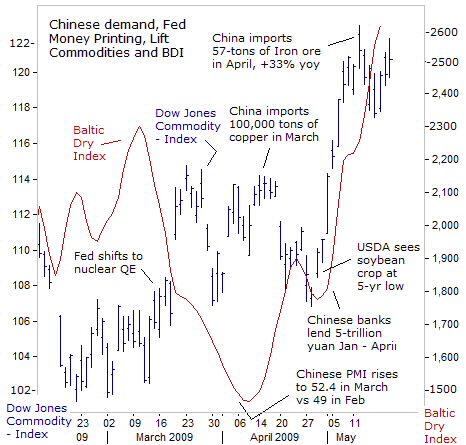
Already, the "green shoots" of future inflation are sprouting forth in the commodities market. Base metals, energy, grains, and fertilizer are charging higher, spurred along by China’s great sucking sound, as Beijing pursues a major effort to stockpile raw materials, with prices hovering near multi-year lows. Beijing is spending 4-trillion yuan on infrastructure, to bring its roads, ports, airports, power-generation capacity and other infrastructure systems up to speed.
The Baltic Dry Index, a measure of shipping costs for commodities, rose to a seven-month high of 2,645, in London on strong Chinese demand for iron ore, coal, and grains. Crude oil rose above $60 a barrel after China increased crude imports by 14% in April to 3.9-million barrels a day. Soybeans rose to $11.65 / bushel, as US stockpiles are dwindling to a five-year low of 130 million bushels, the USDA said.
China imported 57 tons of iron ore in April, up +33% from a year ago, setting a record for a third month. China’s State Reserves Bureau SRB may have imported 300,000 tons of refined copper in the first quarter of this year. Most base metals will experience "severe" supply constraints in coming years as a lack of investment and exploration prevents miners from meeting demand when the global economy recovers, Ernst & Young warned on May 12th. "When that happens, expect metal prices to set new record highs."
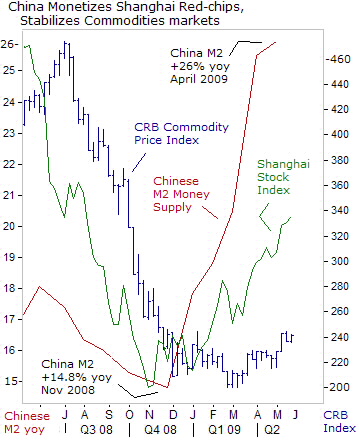
In this case, the revival of the "Commodity Super Cycle" is also getting charged up by Beijing’s printing press, where the ruling elite are expanding the Chinese M2 money supply at a blistering +26% annualized clip, far above the +14.8% rate seen last November. Chinese banks have extended 5.2 trillion yuan ($750 billion) of new loans in the first four months of this year, and much of the freshly printed yuan has been funneled into the Shanghai stock market.
"Significant changes in the growth rate of money supply, even small ones, impact the financial markets first. Then, they impact changes in the real economy, usually in six to nine-months, but in a range of three to 18 months. The leads are long and variable, though the more inflation a society has experienced, history shows, the shorter the time lead will be between a change in money supply growth and the subsequent change in inflation," according to the late economist Milton Friedman.
Capitalizing on the still privileged position of the US dollar, the American ruling class is funding bailouts of the Wall Street Oligarchs through the sale of massive volumes of debt on world markets. The Fed’s policy of printing vast quantities of money, in part to finance the Treasury’s debt has an inflationary lag effect that has generated an extremely nervous reaction from other powers, most noticeably China, which has over $1 trillion in dollar-denominated bonds. These assets would plunge in value in the event of a major upswing in inflationary pressures.
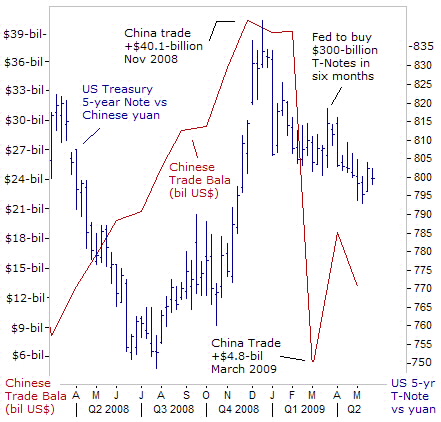
The latest TIC report claims that China, the largest holder of US Treasury securities, increased its holdings of US Treasury bonds by $23.7 billion in the month of March to a record $767.9 billion. Yet the US Treasury’s figures are at odds with stark warnings issued by top Chinese monetary officials on March 25th. Zhou Xiaochuan, chief of the Chinese central bank is calling for a new international currency to replace the US-dollar. Li Xiangyang of the government-backed Chinese Academy of Social Sciences called the Fed’s radical QE policy "irresponsible," and asked for "specific measures on the part of the US to insure the value of Chinese holdings."
Earlier, on March 13th, Chinese Premier Wen Jiabao held a news conference to send a blunt message to Washington. "We have lent a massive amount of capital to the United States. Of course we are concerned about the safety of our assets. To be honest, I am a little bit worried," said Wen. Furthermore, China’s trade surpluses are shrinking compared with a year ago, less than half compared with a year ago, leaving Beijing with fewer dollars to reinvest in the Treasury market.
It’s a vast stretch of imagination to believe the TIC reports are accurate, and not the configurations of "mark-to-make-believe" accounting. Yet China is caught in a bind. If it tries to lighten up on its US bond portfolio, it could trigger a global stampede to dump US debt securities and shoot itself in the foot. Still, it’s highly possible that the US Treasury is doctoring-up the TIC data, in order to prevent an imminent collapse of the debt bubble, which could send interest rates sharply higher.
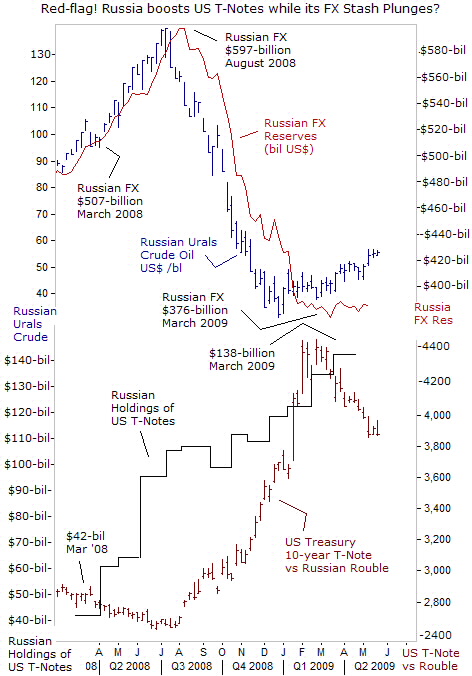
Very few analysts, if any at all, have questioned the accuracy of the TIC data. The most glaring red-flag is the US Treasury’s claim that the Kremlin boosted it holdings of US Treasury debt by $30-billion from August 2008, until March 2009, to a record $138 billion. Yet over the same time span, the Kremlin sold $221 billion US dollars from its foreign currency stash, in a heroic defense of the Russian rouble from the whims of speculators, and massive capital flight from the Russian markets.
Furthermore, the US dollar's share of Russia’s FX stash fell to 41.5% from 47.0 last year, according to Bank Rossii. Russia, along with China, has raised the idea of replacing the US-dollar as global reserve currency, as the Fed tries to massively inflate its way out of the recession and bailout Wall Street Oligarchs. By any stretch of the imagination, it’s impossible to believe the accuracy of the US Treasury’s TIC report, claiming that Moscow increased its exposure to US-bonds.
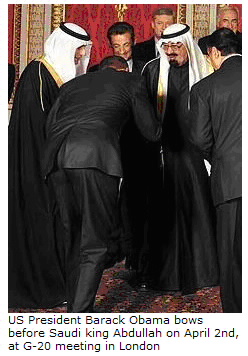
Brazil and China are working towards directly exchanging their own currencies in trade transactions rather than using the US-dollar as an intermediary, according to Brazil’s central bank and aides to Luiz Inácio Lula da Silva, Brazil’s president. "What we are talking about now is Brazil paying for Chinese goods with reals and China paying for Brazilian goods with renminbi." The move follows other challenges by Beijing to the status of the dollar as the world’s leading reserve currency, such as currency swaps with Argentina and Indonesia.
The other key players in the US dollar, the Arab oil kingdoms, are sticking with their archaic dollar pegs, and still demanding US dollars in exchange for their oil. No wonder US president Barack Obama decided to bow before Saudi king Abdullah on April 2nd, at the G-20 meeting in London - a friendly gesture, but also sending an ominous signal of the US dollar’s precarious position.
On May 20th, Iranian president Mahmoud Ahmadinejad said his army tested a missile that could hit Israel and US military bases in the Persian Gulf; coming a day after Iran’s supreme leader the Ayatollah Khamenei accused the Americans of promoting terrorism. "The Sejil-2 missile, which has an advanced technology, was launched today, and it landed exactly on target," Ahmadinejad said. That target was the crude oil pits in London and New York, - lifting Iran’s foreign exchange income, and the value of its gold reserves in one quick-blow.
Iranian defense chief Mostafa Mohammad Najjar said the Sejil-2 has "great destructive power" and that mass production of the missile had started, rattling the nerves of the neighboring Arab oil monarchies. The Obama team was unmoved, however - and still seeks "vigorous" diplomacy with Tehran’s mullahs.




